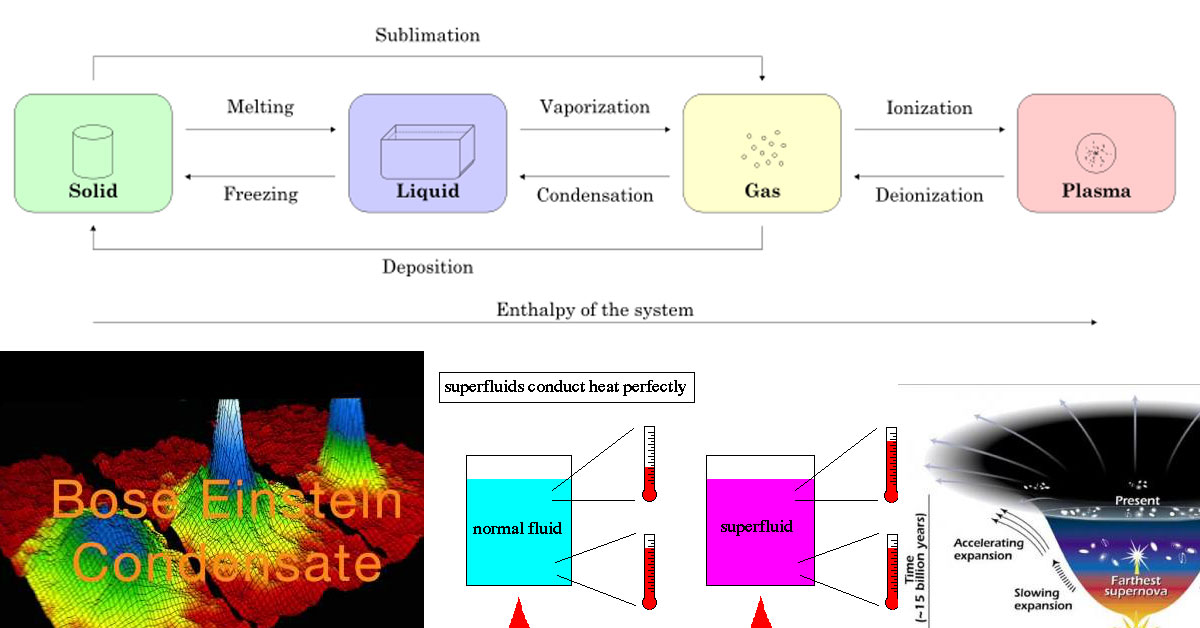There are four fundamental states of matter, and then many more additional ones. Thus, there are more than four states of matter.
There are More than Four States of Matter fact

The Four Fundamental States of Matter and The Many Related Phases of Matter
The classical states of matter observable in every day life are solid, liquid, gas, and plasma, but there are many other known states of matter.[1][2][3]
Other states of matter occur only in very specific conditions such as low-temperature states, high-energy states, and very-high-energy states. Some of these states of matter have been confirmed in the lab, and some are only theoretical.
In general it works like this:
Non-classical states aside, all matter exists as one of four classical states (“the four fundamental states of matter”):[4]
- Solid (definite shape and volume).
- Liquid (definite volume but not shape).
- Gas (no definite shape or volume).
- Plasma (no definite shape or volume, responds to electromagnetic force).
There is also a large number of other states that are transition states or are, as noted above, low-temperature, high-energy, and low-energy states.
These include a “fifth state of matter” Bose–Einstein condensate ( a low-temperature state of a dilute gas of bosons cooled to temperatures very close to absolute zero).
Bose-Einstein Condensate – A New State of Matter.Furthermore, we can consider all of the following phase transitions.
Phase transitions (transitions between states, not pure states) between the solid, liquid, and gaseous phases of a single component, due to the effects of temperature and/or pressure:
- Melting
- Freezing
- Boiling
- Etc; As seen in the table below:
| To | |||||
|---|---|---|---|---|---|
| Solid | Liquid | Gas | Plasma | ||
| From | Solid | Solid-solid transformation | Melting | Sublimation | — |
| Liquid | Freezing | — | Boiling / evaporation | — | |
| Gas | Deposition | Condensation | — | Ionization | |
| Plasma | — | — | Recombination / deionization | — | |
We can can also consider non-classical states like:
- Glass. A non-crystalline or amorphous solid material that exhibits a glass transition when heated towards the liquid state
- Crystals with some degree of disorder. Crystals with “long-range” order on the whole but some rotational freedom.
- Liquid crystal states. Crystals able to flow like a liquid, but exhibiting long-range order.
- Magnetically ordered. Matter bound and organized by magnetism.
- Microphase-separated. Like an “oil and water” effect where one part of a “copolymer” has a different structure than another (like two phases of matter in one object).
TIP: Then the “time crystal” (a lab created state of matter). A time crystal, space-time crystal, or four-dimensional crystal, is a periodic structure that repeats in time and space. See the video below.[5]
There’s A New Form Of Matter That Exists In Four Dimensions!Low-temperature states:
- Superfluid. A liquid that takes on a state of zero viscosity (or infinite fluidity; i.e., flowing without friction) when cooled to very low temperatures.
- Fermionic condensate. A state similar to the Bose–Einstein condensate but composed of fermions.
- Rydberg matter. An exotic phase of matter formed by Rydberg atoms usually consisting of hexagonal planar clusters.
- Quantum Hall state. An electromagnetic state related to the Hall effect.
- Photonic matter. A phenomenon where photons interacting with a gas develop apparent mass, and can interact with each other, even forming photonic “molecules.” This is opposed to photons moving through empty space with no-rest mass or interactions with other photons. Learn more about photons.
- Dropleton. A “quantum fog” of electrons and holes that flow around each other and even ripple like a liquid, rather than existing as discrete pairs
High-energy states:
- Degenerate matter. Under extremely high pressure, as in the cores of dead stars, ordinary matter undergoes a transition to a series of exotic states of matter collectively known as degenerate matter. These states include electron-degenerate matter and neutron-degenerate matter found inside white dwarf and neutron stars respectivly.
- Quark matter. Quark matter or quantum chromodynanamical (QCD) matter is a group of phases where the strong force is overcome and quarks are deconfined and free to move.
- Color-glass condensate. Color-glass condensate is a type of matter theorized to exist in atomic nuclei traveling near the speed of light.
Very high energy states like a the gravitational singularity predicted by general relativity to exist at the center of a black hole (not an actual state of matter; but close).
Other proposed states
- Supersolid. A supersolid is a spatially ordered material (a solid or crystal) with superfluid properties.
- String-net liquid. In which atoms have apparently unstable arrangement, like a liquid, but are still consistent in overall pattern, like a solid.
- Superglass. A phase of matter characterized by having both superfluidity and a frozen amorphous structure.
- Dark matter (unconfirmed). A mysterious form of matter(?) that comprises 83% of the mass of matter in the universe.
In other words, there are way more than four classical states or even “five states” of matter. For more, see Wikipedia’s State of matter (each state of matter is its own subject and we only notably touch on the basics here).
We Found Another State of Matter: The Supersolid!